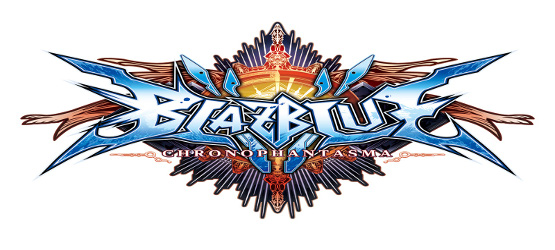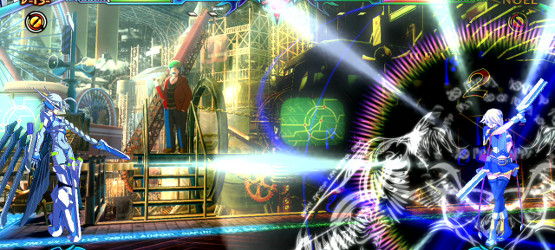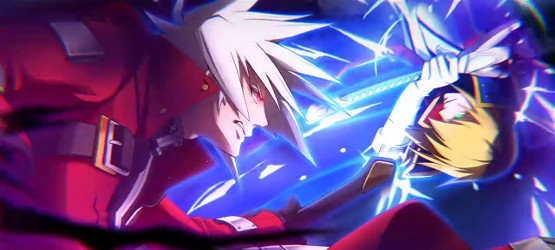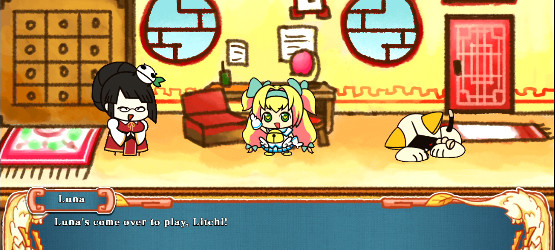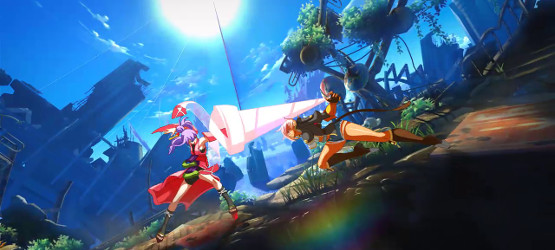BlazBlue Chrono Phantasma is the third standalone title in the BlazBlue series of fighting games. The BlazBlue series are hand-drawn 2D fighting games which feature a diverse cast of characters with equally diverse play styles. More importantly, the BlazBlue series is one of the best fighting games for both fighting game beginners and veterans; something Chrono Phantasma embraces wholeheartedly.
A fairly straightforward, if initially imposing menu screen appears when loading up Chrono Phantasma. The first tab is the training menu. Contained within are the tutorials and the Training and Challenge Modes. Chrono Phantasma has an in-depth tutorial which explains a lot of the in-game systems at a decent pace. However, this tutorial is given by the characters in their in-game personas and mileage varies on how annoying each character may become. Players can choose to use Japanese or English voice actors, and it is highly recommended to change this setting to the player’s liking due to the amount of dialogue spoken during the tutorial. Tutorial sets up the two different play modes used throughout the game – Stylish for casual players and Technical for everyone else.
Stylish mode takes the game’s relatively simple combat system and makes it even simpler. Gameplay normally flows using combos. Pressing □, ∆, ○, and then x in order will unleash a basic combo. Special moves tend toward the simple as well, with quarter to half-circle inputs on the d-pad or analog stick along with the appropriate button press making up the bulk of the specials. Stylish mode analyzes player and enemy position and makes a judgment about which would be the best move to use in that situation. Regular blocking is automatic, but other types of blocks must be performed manually by the player. This negates much of the advantage Stylish mode would give over opponents using Technical mode. And really, Stylish mode exists mostly due to Story Mode; but I applaud its inclusion. Stylish mode is a good way to get a feel for characters a player would not normally attempt, as well as bring new players into the fold.
Gameplay is very fluid and even without the tutorial it will be easy to see how combos flow together to create a good fighting style. Few characters have styles which overlap. Each character has a ‘Drive’ or unique ability for their play styles. Many drives are further differentiated by the addition of another gauge utilizing the Drive. Some Drives switch stances and thus attacks. Others have power gauges, nail counters, and other actions. In truth, I am not certain how each individual Drive works, but Chrono Phantasma makes it clear delving into each is a personal and time-consuming choice. These varied play styles make it a lot harder to become good at each character, but at the same time present a decent challenge and offers up a lot of replay value.
Arcade Mode will be the game’s bread and butter. Fights are in a series of eight with some story taking over the last few fights. Characters with histories in the game might open with a small fighting display before their battles. Playing Arcade with all the characters will bring together pieces of the story, but it’s the game’s Story Mode which has been the BlazBlue series’ second strongest feature. The story for Chrono Phantasma may not make a lot of sense for players who missed the first two installments, but the plot is fairly obvious after a few scenes. The game offers some humorous segments called “Teach Me More, Miss Litchi” about the background events in the world of BlazBlue for players interested in catching up. Story Mode is presented by using a visual novel interface interspersed with battles. Since players are limited to usable characters from the chapter currently being viewed; players are encouraged to either cultivate a playable knowledge of available characters or turn on Stylish mode. The story is not bad, but players looking for fights may be left squirming in their seats waiting for the next match in between character dialogue.
The game has several different other modes, including a versus and score attack mode. Abyss Mode is a fight dungeon, and players must battle through opponents one after the other with only a little bit of health restoration between fights. Fights are one bout per encounter and the goal is to clear the dungeon while earning cash and upgrades. Cash is available across all aspects of the game, but upgrades are character specific and must be bought before each dungeon run. However, items earned in a dungeon are automatically used while in that dungeon. Many items greatly increase parameters and dungeons can be played over and over again for random drops. Accumulating goods before entering an abyss is a good strategy. However, harder dungeons have a better increase in stat gains, making Abyss Mode the time-honored cross between RPG management and good ol’ fightin’.
Unlimited Mars Mode is very simple – the player is pitted against a track of 10 opponents which fight at the highest level the game can muster. This is probably the most thrilling and difficult single-player mode in the game. Sadly, each attempt has left a poor, curb-stomped Noel Vermillion on my screen and dank pity in my thumbs.
Online Mode is where most players will eventually find themselves. The first two days of online play were a little dead, but as of this writing the online mode has picked up tremendously. One of the most adorable functions about online mode is customizing a little pixel avatar of the game’s characters, heading to one of several lobbies based upon the game’s cities, and jumping on an arcade platform to duel other players. Text messages and emoticons can be used in the lobby to help immerse players. There are a lot of little touches like this throughout the game which really bring out character. I’m pleased to report I encountered absolutely no slowdown while playing online. Just a heads up, this is only available for player matches and not ranked matches.
Chrono Phantasma brings back all of the previous BlazBlue characters and bosses, including Continuum Shift’s DLC characters. The new lineup consists of Bullet, Azrael, and Amane Nishiki. Bullet and Azrael are close combat fighters while Amane is a distance fighter. Bullet’s Drive causes her stats to increase when Drive attacks hit opponents. Azrael’s marks his opponents with an exploitable weak spot. Amane turns his sash into drills, and of the three is both the easiest and most fun to use. His Astral Finish is absolutely fantastic and should be tried on everyone since it reveals their “younger self”. Noel has a new character design, but her play style harkens back to Calamity Trigger with a couple of small exceptions. Many of Jin’s moves require the Heat gauge to be used, limiting is spam abilities significantly. Nu-13 is back and my world is worse for it. There are other changes, but these are the most significant.
I would state the Technical Mode gameplay in Chrono Phantasma really is for skilled and expert players. This may seem like a no-brainer; especially given the existence of Stylish Mode, but it has become readily apparent the series is growing with its players and becoming better for it. Many of the newer characters tend to have combos which require more precise timing with moves only able to be executed after a prior move. Older characters tend to have more “stand-alone” move sets that combo well into each other. Few truly skill-based games are often unable to find the balance between incorporating new players and existing userbase, and Chrono Phantasma has found a way to embrace both while giving up very little in return.
As stated above, players can choose which language they would like to hear spoken during cutscenes. Personally, I turned on the Japanese voiceovers since it was much less painful on the eardrums. Fans of 90’s dubbed anime; before the current talent became staples, may experience flashbacks.
Thankfully, the rest of Chrono Phantasma’s audio is superb. The music is very good, and many tracks appropriately rock out for combat. Animation is done very well – not only do the characters look and move nicely, but the stages are beautifully done. Stages often combine 2D and 3D art with multiple layers and lots of little background events placed throughout each level. Combined, the audio and video for Chrono Phantasma is an outstanding combo; a one-two punch which makes the game stand out, even among its peers.
Part of the Chrono Phantasma’s charm is the amount of extra material Arc System Works places into the game. The gallery for Chrono Phantasma is tremendous, and encompasses a wide array of purchasable sketches, in-game art and cinematics, and what appears to be softcore porn sent to Japanese gaming stores as promotional pieces. Birthday cards featuring and for the characters are available. Comments from artists are also available for most of the pictures, and reading many of them will elicit either a chuckle or an awkward moment you hope no one walks in on.
There are few downsides to Chrono Phantasma. While the game is fun the amount of energy it takes to play for long periods is draining. The roster is nice and familiar, but at the same time the slow influx of new characters or replacement characters may make returning players feel BlazBlue has grown slowly or gotten stale. Story mode is a key piece of Chrono Phantasma, but its enjoyment will be limited to how much a player enjoys Japanese fantasy and science fiction. There is also the issue of time investment versus potential payoff. Much of the personal gain from fighting games is the ability to overcome a tough opponent using your skills. Stylish Mode is a way to essentially skip past acquiring skill and may cheapen the game for players who play in Technical Mode.
However, these are nitpicks in the face of a very well put-together fighting game. Chrono Phantasma lives up to its predecessors and in some instances surpasses previous titles. Players picking up this title are in for a solid experience which will likely bring several hours of gameplay and keep you coming back for more.
-
Combat is fast and fun
-
Different gameplay options for different levels of experience
-
Lots of modes and things to do
-
The music, animation and backgrounds are outstanding
-
Returning players may find themselves underwhelmed by character selection
-
Story mode's enjoyment may be limited to fans of anime
-
But really, not much wrong here
